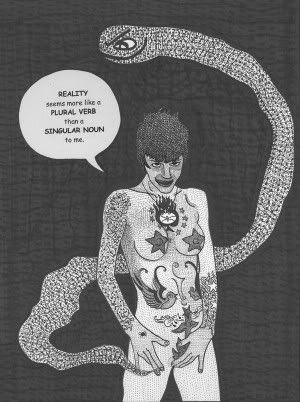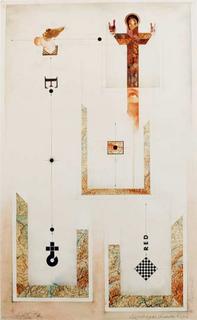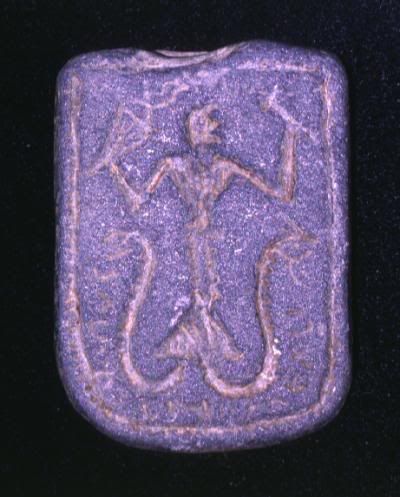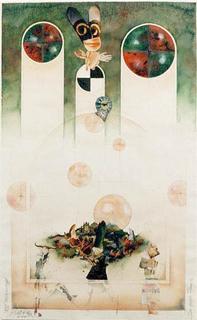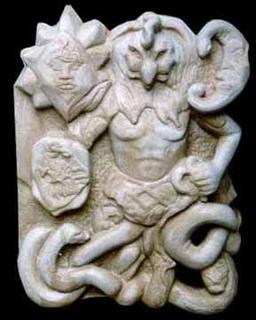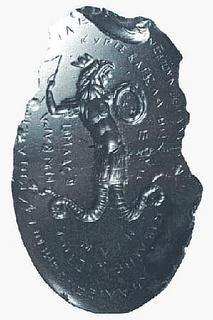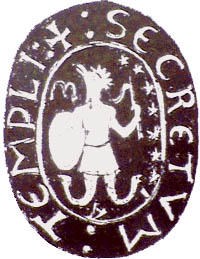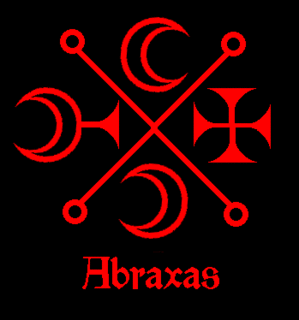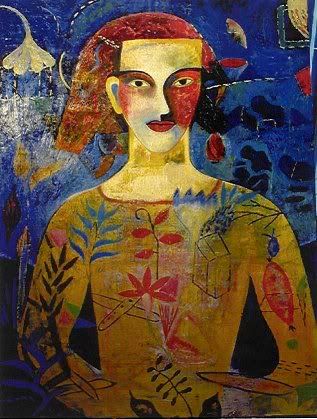 The Gnostic JungAnd the Seven Sermons to the Deadby Stephan A. HoellerQuest Books – 4th printing 1994
The Gnostic JungAnd the Seven Sermons to the Deadby Stephan A. HoellerQuest Books – 4th printing 1994The Seven Sermons to the Dead is a mysterious, little known or understood work of C. G. Jung’s, which was privately printed in German, without copyright or date, sometime between 1920 and 1925, and distributed to a select group of friends. Stephan A. Hoeller copied, then translated it from the original. Then he wrote a book in which he not only calls The Seven Sermons a Gnostic document, but also claims that Jung himself was a modern Gnostic.
The Gnostic Jung is essentially an attempt – and a very good one at that – to interpret the Seven Sermons, and they certainly need interpretation. Along the way, Hoeller, an almost worshipful admirer of the “Wise Man of Küsnacht”, gives us a clear, skillful elucidation of some of Jung’s essential ideas. But the question is: Was Jung really a Gnostic? Certainly he admired Gnostic thought and his works are liberally sprinkled with references to them. But he never called himself a Gnostic; on the other hand he never identified with any philosophical or religious stream but his own psychoanalytical specialty.
Without doubt Jung’s kind of psychoanalysis was different, approaching what could be called a path of initiation, the analyst becoming a hierophant and the patient a neophyte, or disciple. Mental illness was considered to be a divided or incomplete condition and health as a state of spiritual wholeness – or near wholeness. Jung always insisted that his writings were based upon empirical evidence and personal experience – and not mystical speculation. After his death and the publication of his autobiography, Memories, Dreams and Reflections, and disclosures by his most intimate disciples, it be came clear that Jung underwent an intense period of spiritual experience between 1912 and 1917. This may explain his insistence on the word “empirical” to describe his investigations. The only fragment of his writings from that period which he permitted to be published was The Seven Sermons to the Dead, using terminology and style of second century Gnosticism. Jung attributes the authorship to Basilides, a Gnostic sage who taught in Alexandria around A.D. 125-140. Whether this implies some sort of mediumship or automatic writing is a matter of speculation. However, it should be borne in mind that it was the practice for centuries to ascribe authorship of spiritual treatises to someone who the real author considered to be more spiritually advanced than himself.
It would be futile to attempt a synopsis of Hoeller’s interpretation of The Seven Sermons to the Dead here. At best we can consider a few aspects which especially interested this reviewer.
Western materialism has caused many seekers of spirituality to direct their search toward Eastern mysticism. Jung, surprisingly, contended that the search for the wisdom of the East had almost darkened the mind of the West and that it is a search that continues to lead many astray. It isn’t only the impact of alien cultures that can be dangerous to the Western soul. Much of Hindu and Buddhist thinking is directed towards the obliteration of individual consciousness (egolessness)
“When desire is snuffed out by a variety of meditation and concentration practices, what remains is a psychic corpse from which the libidinal cosmic force of the vital urge has been artificially removed. One can perish of psychic pernicious anemia as well as from its physiological analogue, and the fulfillment of such objectives as desirelessness and egolessness may very well lead to just such a condition. The desire for self-knowledge is just as much a desire as the desire for food or sex.”
In his work The Archetypes of the Collective Unconscious Jung restates the message contained in the Second Sermon when he says: “Evil is the necessary opposite of good, without which there would be no good either. It is impossible to even think good out of existence.” Jung was insistent especially on the reality and titanic magnitude of evil, for he felt that western humanity, beginning with Christian theology, has consistently and disastrously dwarfed the picture of evil as arising from the unconscious of humanity. In Civilization in Transition he wrote that evil “is of gigantic proportions, so that for the Church to talk of original sin and to trace it back to Adam’s relatively innocent slip-up with Eve is almost a euphemism. The case is far graver and is grossly underestimated.”
President Bush has been criticized for calling bin Laden and the terrorists responsible for the WTC destruction “evil”. The critics are not saying that bin Laden is “good”, rather are they implying that evil doesn’t exist and we should look for reasons in socio-economic injustice. Although it is not possible to deny that social injustice exists in the world, it would be difficult indeed to characterize these terrorist acts as anything but evil, if we take Jung’s point of view seriously. Of course there are many other kinds of what seems to be pure evil in the world. According to Jung, good and evil are not two opposite poles of a linear dimensionality. They resemble a circle wherein going far enough in either direction is likely to associate one with the opposite polarity. He said that there is no good that cannot produce evil and no evil that cannot produce good. To put this is mundane practical terms – the WTC event could just prove quite beneficial to the Afghans who, long ignored, have already been freed from the Taliban and have been promised much aid.
Hoeller’s Jungian comment on astrology:
"The unenlightened or unconscious person is ruled by the planets, or rather by the psychological force and complexes which are signified by the planets. Thus the unconscious, or non-Gnostic person, is enthralled by the force of Mars when anger invades his personality; another may be possessed by Venus when under the spell of romantic desire; the curiosity and acquisitiveness of Mercury may dominate another, and so on. Unlike the common superstitious believer in popular astrology, the Gnostic considers domination by planets and other heavenly bodies as an invasion of his spiritual privacy, an assault on the sovereign prerogatives of his royal selfhood. Abraxas, the summation and ruler of the sevenfold planetary spectrum, is thus the true archetype of man’s potential freedom and independence from unconscious psychological pressures and compulsions."
The Gnostic teacher Carpocrates, as opposed to the official Christian dogma that salvation is the result of a single, unrepeatable event – the crucifixion of Jesus – postulated this process as continuing through a number of lives of earth. Jung, as far as I know, never included the concept of reincarnation in his psychological works. However, in Memories, Dreams and Reflections, near the end of his life, he muses:
My life often seemed to me like a story that has no beginning and no end. I had the feeling that I was an historical fragment, an excerpt for which the preceding and succeeding text was missing. I could well imagine that I might have lived in former centuries and there encountered questions I was not yet able to answer; that I had been born again because I had not fulfilled the task given to me.
According to his theory of wholeness being the conjunction of opposites, Jung always affirmed conscious existence after death and, since one opposite is not possible without the other, neither is “good” or “bad” in itself. We moderns, however, consider death to be an implacable enemy, and therefore idolize youth and life. This is as much an error as the idolization of death, a la bin Laden.
Jung called the process of spiritual growth “individuation”, which requires that individual values replace collective ones. Much is made of group dynamics nowadays and it is certainly true that we need to feel ourselves as members of a group or nation as long as the fullness of the individuation process has not been achieved. But the objective is something quite different and it should be brought to consciousness:
Beneath the thin veneer of culture the wild beast lurks… But the beast is not tamed by locking it up in a cage. There is no morality without freedom. (Jung)
The Sage Lao Tzu goes so far as to recognize the value of the individual principle in the collective area of the state and society: The more taboos and prohibitions there are in the world, the poorer people will be. The more sharp weapons people have, the more troubled the state will be. The more cunning and skill man possesses, the more vicious things will appear. The more law and orders are made prominent, the more thieves and robbers there will be.
We are guilty. Are we? Are we guilty of so much? The Catholic and other churches continue to torture children with a sense of guilt because of sins of the flesh such as masturbation and, following what Moses is supposed to have received from the burning bush, adultery – as defined by religious authorities of course. Neither Christian, Jew nor Muslim may even look at a woman in a certain way without exposing himself to the pangs of hellfire. It is not contemplated that women might be subject to similar temptations, so they seem exempt from at least this prohibition. What do little girls confess anyway? The rationalist on the other hand – thanks to Dr. Freud – must be subject to a similar guilt, but which results from yielding to desires arising from instinct, which Freud conceived as a sin against reason. Moses and Freud are both proponents of a lonely, bitter God “…who recognizes no equal and therefore cannot experience the delights and rejections, the agony and the ecstasy of the opposites. Monotheistic orthodoxy and atheistic rationalism are brothers under the skin. The all-spiritual God and the all-logical deity of reason are both blind; neither can accept …his polar opposite and relate to it in creative conflict. Both have fostered a dreary and burdensome condition of mind which is characterized by Judeo-Christian guilt augmented by Freudian neurotic hopelessness.”
According to Jung (or at least to Hoeller, his interpreter here), the individuation of humankind reaches on the one side into the heavens where the divine mother of eternal mind (Mater Coelestis) waits to receive us, while on the other it is rooted in the subterranean power of the phallic Eros (Phallos), the earthly father, whose strength and energy furnishes the force whereby we can ascend. The final union of heaven and earth begets the androgynous Anthropos, the New Man, the Christ of the Gnostics – “the paradigm of the transformed and individuated ego of every individual and of all humanity”. By recognizing the celestial beloved of the Eternal Feminine, Jung’s Sermons agree with Goethe’s vision of the Mater Coelestis in Faust:
All that is past of us
Was but reflected;
All that was lost in us
Here is corrected;
All indescribable
Here we descry;
The Eternal Feminine
Leads us on high.
Today, humanity’s greatest need is the attainment of wholeness which comes to the soul in the form of Gnosis. Religious fanaticism, moral fervor, political ideologies – none are solutions, rather are they dangers to the world and to the individual. As long as many, if not the majority of us, expect all problems to be solved outside of ourselves, we will be beset by “inhumanity upon inhumanity, holocaust upon holocaust”. The predicament we need to resolve is one of a-gnosis – a lack of intimate, personal, experiential knowledge of our authentic nature.
Whether C. G. Jung was the authentic successor to the Gnostics must be judged by each reader. I know of no better place for weighing the arguments then this book, written with a flowing pen by an expert in Jungian thought.
Frank Thomas Smith


